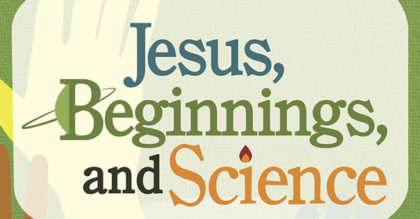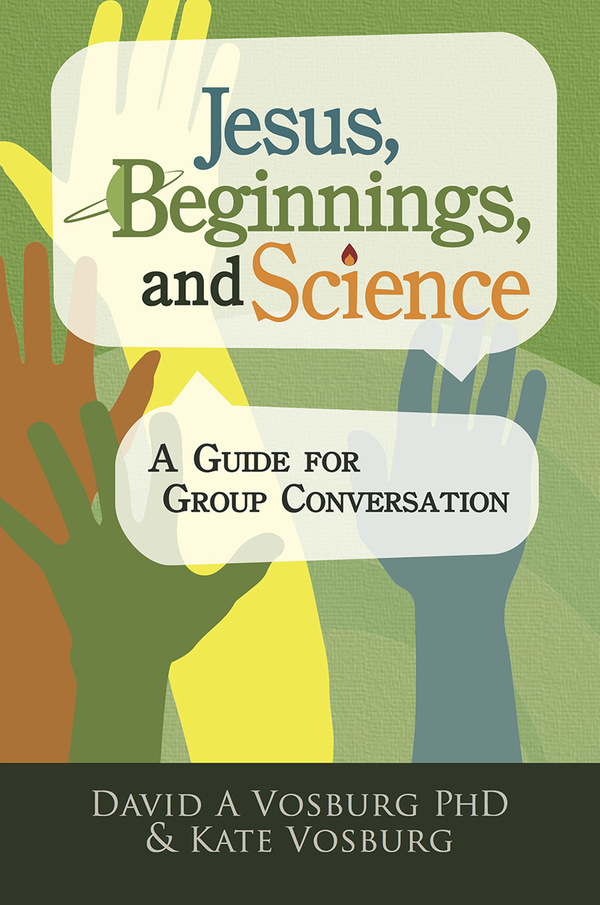
Jesus, Beginnings, and Science from ESN contributor David Vosburg and his wife Kate Vosburg is a significant change of pace from the book we’ve been discussing recently, Quantum Physics and Theology. On some level though, the Vosburgs’ aim is the same as Polkinghorne’s: encourage readers to consider or continue following Jesus even as they study science. The approach here is to provide a discussion guide for communities large and small looking to have a conversation about where science, especially contemporary science, fits into a Christian faith serious about Jesus and the Bible. I think this book would be a valuable resource for such communities and conversations, particularly for those new to the topic and looking for somewhere to start. And I would be glad for the opportunity to test it out in such a setting.
The Vosburgs introduce the guide as an outgrowth of conversations they were already having on the university campuses where they work. As a result, they anticipate a number of the usual questions, demonstrate sensitivity to challenging issues, and also introduce some helpful perspectives that rarely occur to those approaching the broad topic of science and Christianity for the first time. For example, many have questions about creation and the first chapters of Genesis, so the Vosburgs immediately draw attention to the myriad passages elsewhere in the Bible that discuss creation. This move simultaneously acknowledges where the reader is likely coming from and broadens the scope of the discussion to draw the reader in deeper.
The guide has three parts, each with four chapters for a 12-week discussion that fits nicely into the semester schedule of most colleges and universities, where I imagine this guide will be especially welcome. The first part examines a range of Bible passages on creation, drawing particular attention to the role ascribed to Jesus in that process. The second part touches on human origins more specifically including but not limited to the possibility of an evolutionary origin. The third part deals with science more broadly as a way of knowing and a possible vocation. I’ll admit the sequence of topics surprised me a little, but there is something to be said for the Vosburgs’ experience informing the arrangement. And I can see where it may very well correspond to the questions newcomers have, rather than a more analytic lens starting with the most fundamental issues.

Practically, I appreciate the complete and largely self-contained nature of the guide. Each chapter has a comprehensive outline for a group meeting, including the full text of Bible passages to study, suggested worship songs and pointers to further reading. The inclusion of the Bible passages in particular feels like a thoughtful touch for group participants who are unfamiliar with the Bible and how to find specific texts. Just about the only thing missing that would be needed to lead a group as the guide suggests is those worship songs, which would be prohibitive to reproduce. Plenty of books intended for discussion groups have a whole curriculum around them with videos and workbooks and so on; those have their place and their merits, but there’s also something to be said for a complete resource in a single volume.
Of course, there are plenty of opportunities to supplement with additional material from other sources if your group so desires. The Vosburgs provide a good survey of the breadth of science and Christianity issues, particularly from the theological side. Still, the book is a guide not a textbook and so cannot provide too much depth. Notably, if you are looking for scientific details on how the age of the earth is estimated or what evidence exists for (or against) evolutionary biology, you will need to look elsewhere. At one point, I actually got the impression the authors expected group participants would be looking up the science on their smartphones as they chatted, which probably isn’t unwarranted.
For those looking for more science than a quick search can provide, the book also has a substantial bibliography to lead the reader further into details. Each chapter offers a handful of further reading suggestions specific to the topic of that chapter, and the last 10% of the book is a more comprehensive bibliography broken down into several categories. There are books, videos, and online resources referenced so the reader can find something in a format most helpful to them. Where significant divergence of perspectives exists within the Christian community, each of the major alternatives is represented. There’s probably little uncertainty about how the Vosburgs approach Biblical interpretation, especially of Genesis 1-3, and scientific interpretation, but they are not here to tell you what to conclude. They want to help you have an informed conversation within your own community.
While this is not the kind of book you’ll want to sit down and read front to back, an interested reader who is not currently part of a discussion group might still find this guide worthwhile for the bibliography alone. But its greatest value will almost certainly be for those who can use this guide as intended to facilitate conversations on science and Christianity than can otherwise be tricky or intimidating to start.
The publisher provided me with a copy of the book for this review. They also provided me with another copy to give away to one of you! Note: Giveaway closed on 11/1/2017.
Andy has worn many hats in his life. He knows this is a dreadfully clichéd notion, but since it is also literally true he uses it anyway. Among his current metaphorical hats: husband of one wife, father of two teenagers, reader of science fiction and science fact, enthusiast of contemporary symphonic music, and chief science officer. Previous metaphorical hats include: comp bio postdoc, molecular biology grad student, InterVarsity chapter president (that one came with a literal hat), music store clerk, house painter, and mosquito trapper. Among his more unique literal hats: British bobby, captain’s hats (of varying levels of authenticity) of several specific vessels, a deerstalker from 221B Baker St, and a railroad engineer’s cap. His monthly Science in Review is drawn from his weekly Science Corner posts — Wednesdays, 8am (Eastern) on the Emerging Scholars Network Blog. His book Faith across the Multiverse is available from Hendrickson.

Leave a Reply